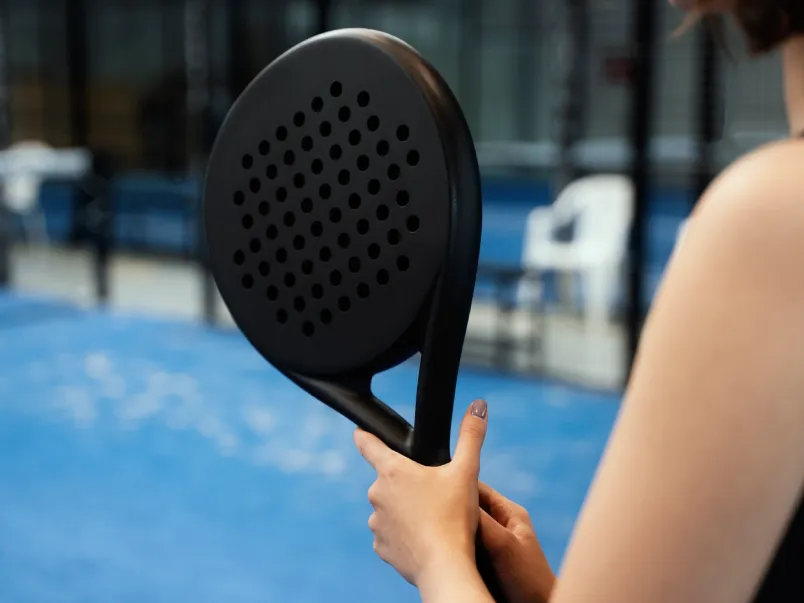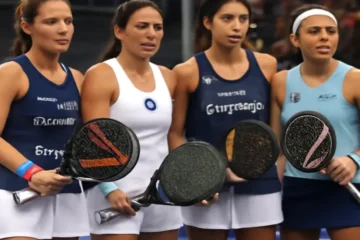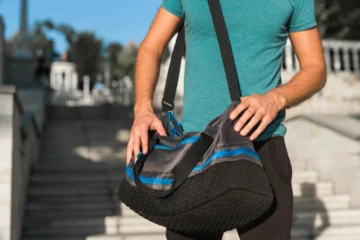More Than Just Holding the Racket
Have you ever hit a shot in padel that just didn’t have the power you expected, or felt that your volley lacked control when you needed it most? The issue might not be your swing or technique but how you’re holding the racket.
In padel, your grip is the only point of contact between you and your racket. The grip you choose can make all the difference in your game, influencing everything from the power you generate to the precision of your shots and the amount of spin you can create. Whether you’re a beginner looking to build your foundation or an intermediate player seeking to refine your technique, finding the right grip is crucial to improving your performance on the court.
In this guide, we’ll dive into the two primary grip families—Continental and Eastern—and explore their variations. By the end, you’ll have a clear understanding of which grip suits your playing style and how to transition seamlessly between them for optimal performance.
1. The Foundation: Understanding the “Bevels”
Before diving into specific grips, it’s essential to understand the basic structure of the padel racket handle. The grip is not just about how your hand wraps around the handle; it’s also about the angle at which you position your hand.
Simple Explanation: The Bevels
A padel racket has an octagonal handle with eight flat surfaces, commonly referred to as “bevels.” To determine your grip, you’ll place your index finger’s base knuckle on a specific bevel. This simple yet crucial detail defines your grip style.
Think of it like a clock face, where the bevels are numbered from 1 to 8, starting from the top of the racket handle. Your grip will shift depending on where you position that knuckle.
Understanding bevels gives you a solid foundation to discuss the different grip types. As we go deeper into each grip, remember that your grip style is defined by where that knuckle lands on the bevels.
2. The Universal Grip: The Continental (The “Hammer” Grip)
The Continental grip is often referred to as the “hammer” grip because it resembles the way you would hold a hammer. The base knuckle of your index finger rests on bevel 2.
Why It’s Essential:
The Continental grip is the most versatile grip in padel. It is considered the “all-rounder” because it works well for almost every type of shot, making it the foundation for most players, especially beginners.
- Ideal for Net Play: It’s perfect for volleys, smashes, and overhead shots like bandejas and viboras. It allows you to maintain a neutral racket face, giving you control over your shots and ensuring consistency at the net.
- Defensive Shots: When you’re defending against balls coming off the back or sidewalls, the Continental grip is your best friend. It provides enough flexibility to adapt to the awkward angles the walls create.
Best For:
The Continental grip is excellent for beginners just starting out with padel. It’s also ideal for players who want a single, versatile grip to use across different types of shots. If you’re looking for a grip that handles the majority of situations with ease, this is it.
Limitations:
While it’s an incredibly flexible grip, the Continental isn’t the best choice for generating heavy topspin on your groundstrokes, especially from the baseline. It’s more suited for defense and net play rather than aggressive baseline shots.
3. The Power & Spin Grip: The Eastern Forehand
The Eastern Forehand grip is a popular choice for players who want to generate more power and topspin, particularly on their forehand shots. To achieve this grip, you position the base knuckle of your index finger on bevel 3.
Why Players Use It:
- Increased Power: The Eastern Forehand grip allows you to generate more power with your swings. It’s particularly effective for baseline players who like to dictate the tempo of the game from the back of the court.
- Topspin Generation: This grip allows for greater topspin on forehand shots, making it easier to bring the ball down into the court after hitting it with force.
Best For:
- Aggressive Baseline Play: If you love to control the rally from the backcourt with powerful groundstrokes, the Eastern Forehand grip is the one for you.
- Players Transitioning from Tennis: If you’re coming from a tennis background, you may find the Eastern Forehand grip familiar as it closely resembles a tennis forehand grip.
Limitations/Caution:
- Not Ideal for Net Play: At the net, this grip can cause your volleys to pop up, leaving them vulnerable to your opponent’s attacks.
- Defensive Challenges: It also makes it difficult to play shots off the back glass. The grip limits your ability to adjust quickly to defensive shots.
Recommendation:
For players who primarily focus on power from the baseline, the Eastern Forehand grip can be a great asset. However, it’s advisable to switch to the Continental grip when you move closer to the net or when playing defensive shots off the glass.
4. Grip Variations and Special Cases
While the Continental and Eastern grips are the most commonly used, there are some variations that can fine-tune your game, especially as you advance.
The Eastern Backhand Grip (Bevel 1):
The Eastern Backhand Grip places the base knuckle of the index finger on bevel 1. Although this grip was more commonly used in the past, it’s now less popular because most padel players find the Continental grip sufficient for backhand shots, particularly when playing volleys and bandejas.
The “In-Between” Grip:
Advanced players often develop a hybrid grip, a blend of the Continental and Eastern Forehand grips. This gives them the flexibility to adapt quickly to different shots during the match. The in-between grip allows for smoother transitions between forehand and backhand shots while providing the versatility needed for competitive play.
5. How to Choose: A Simple Guide to Finding Your Match
Choosing the right grip depends on your level of experience, playing style, and goals. Here’s how to decide:
For the Complete Beginner:
Start with the Continental Grip. It’s the most fundamental and versatile grip to learn. Mastering this grip will allow you to develop all the essential shots correctly, laying a solid foundation for your game.
For the Tennis Player Transitioning to Padel:
You’re likely comfortable with the Eastern Forehand grip. While this grip will give you power from the baseline, it’s essential to also practice the Continental grip, especially for net play and defensive situations. With some practice, you’ll get comfortable switching between grips based on your position on the court.
For the Intermediate Player Wanting More:
- Self-Assessment: Take a moment to assess your game. Are your volleys lacking power or control? Stick with the Continental Grip. If your baseline shots feel weak, try experimenting with the Eastern Forehand for added power and topspin.
- The Key Skill – Grip Switching: As an intermediate player, learning to switch grips smoothly between defense and offense is key. Practice subtle grip changes during points to gain more control over your shots.
6. Pro Tip: The Importance of the “Grip Size”
Choosing the correct grip size is just as important as selecting the right grip style. If the grip size is too small or too large, it can lead to unnecessary strain on your hand and wrist.
The Rule of Thumb:
When holding the grip, you should have about a finger’s width of space between your fingertips and the palm of your hand. This ensures you can comfortably hold the racket without over-squeezing or straining your muscles.
- Too Small of a Grip: This can lead to over-squeezing, which may cause wrist injuries or discomfort.
- Too Large of a Grip: A grip that’s too big can reduce your racket’s maneuverability, leading to elbow strain and potentially tennis elbow.
Make sure to check your grip size regularly, especially if you experience discomfort during or after play.
Conclusion: Grip It and Rip It (With Control)
To recap, the Continental Grip is your all-around foundation, perfect for beginners and versatile enough for defensive shots, volleys, and net play. On the other hand, the Eastern Forehand Grip is ideal for players who want power and spin from the baseline.
But remember, there is no single “perfect” grip for everyone. Your ideal grip depends on your playing style, level, and personal preferences. Spend time experimenting with different grips during practice to find the one that works best for you. The key is understanding how each grip influences your shots, so you can choose the right one for every situation on the court.
FAQs: Essential Padel Grip Styles
1. What is the most common grip in padel?
The most common grip used in padel is the Continental Grip. It is the foundation for most players, especially beginners, due to its versatility. This grip works well for a variety of shots, including volleys, smashes, and defensive shots off the glass.
2. Can I use the same grip for every shot in padel?
Yes, the Continental Grip is versatile enough for most shots in padel, from defensive plays to net volleys. However, for players seeking more power and topspin from the baseline, the Eastern Forehand Grip may be better suited for forehand shots. You can switch between grips depending on the situation.
3. How do I know which grip is right for me?
The right grip depends on your style of play:
- Beginners should start with the Continental Grip to develop their fundamentals.
- Tennis players transitioning to padel often start with the Eastern Forehand Grip for baseline power but should practice switching to the Continental Grip for net play and defense.
- Intermediate players may choose to experiment with both grips, depending on their need for more power or control in different situations.
4. What is the difference between the Continental and Eastern Forehand grips?
The Continental Grip is ideal for versatility, providing control and ease for net shots, volleys, and defensive plays. The Eastern Forehand Grip, on the other hand, is better for generating power and topspin from the baseline, but it’s less effective for net play.
5. Can I use an Eastern Backhand grip in padel?
While the Eastern Backhand Grip exists and can be used, it is rarely utilized in modern padel. The Continental Grip is sufficient for most backhand shots, such as volleys and bandejas, making the Eastern Backhand less relevant.
6. Why is grip switching important?
Grip switching is essential because padel requires quick adjustments based on the situation. For example, when moving from a defensive position to attacking from the baseline, you may need to switch from the Continental Grip to the Eastern Forehand for more power and spin. Learning to switch grips seamlessly during play enhances control and effectiveness.
7. How do I switch grips during a match?
To switch grips, practice making subtle adjustments with your fingers during rallies. For instance, when moving from defense to offense, shift your grip to the Eastern Forehand for power, and return to the Continental Grip when approaching the net. It’s all about adapting quickly to each situation.
8. How do I know if my grip size is correct?
The ideal grip size should allow you to have about a finger’s width of space between your fingertips and the palm of your hand when holding the racket. If the grip is too small, it can cause discomfort or wrist strain. If it’s too large, it may reduce your control and lead to elbow issues.
9. Should I try the Eastern Forehand grip if I’m a beginner?
While the Eastern Forehand Grip offers power and spin, it may not be the best grip for beginners. Starting with the Continental Grip will give you a solid foundation in padel. Once you’re comfortable, you can experiment with the Eastern Forehand for specific shots like powerful baseline drives.
10. Can I mix grips during a match?
Yes, mixing grips is common in padel. Many advanced players use a combination of grips depending on the shot. For instance, you can use the Continental Grip for volleys and defense, and switch to the Eastern Forehand Grip when hitting forehands from the baseline. Mastering grip switching is key to a versatile and adaptive playing style.




